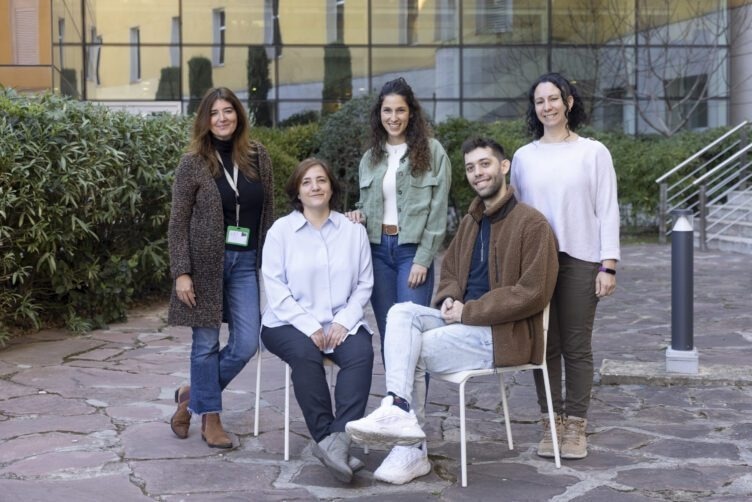Ana Losada, a scientist at the Spanish National Cancer Research Centre (CNIO) and then at the Cold Spring Harbor Laboratory (New York, USA), identified cohesin, a protein essential to the process of cell division, in Xenopus frogs at the end of the 1990s.
 From left to right: standing, Ana Cuadrado, Dácil Alonso-Gil (first author of the paper), and Miriam Rodríguez. Seated, Ana Losada (CNIO Chromosome Dynamics group leader) and Daniel Giménez / Laura M. Lombardía. CNIO. Image Credit: Spanish National Cancer Research Centre.
From left to right: standing, Ana Cuadrado, Dácil Alonso-Gil (first author of the paper), and Miriam Rodríguez. Seated, Ana Losada (CNIO Chromosome Dynamics group leader) and Daniel Giménez / Laura M. Lombardía. CNIO. Image Credit: Spanish National Cancer Research Centre.
Over the next few years, it became obvious that cohesin is responsible for not just one, but numerous essential cell functions, including the folding of DNA into loops. Because the DNA inside each cell is many meters long (if measured linearly), it must be folded to fit inside the cell nucleus; this folding is significant in and of itself because the spatial arrangement of DNA loops has been proven to affect how genetic information is interpreted.
In short, cohesin research is presently a very active area of study. Losada, the head of CNIO’s Chromosome Dynamics Group, continues to lead the field. Her new research elucidates a significant point about how cohesin connects to DNA and moves around the molecule, generating loops.
Their findings, published in the journal Nature Communications, will help better understand the disease Cornelia de Lange syndrome.
One ring to organize the genome
A metaphor for cohesin in action could be a ring that captures two segments of a DNA strand to form a tiny loop that grows in length as the ring travels. The ring is cohesin.
With its particular ring shape, this protein embraces the DNA, and in doing so it can do two jobs. One is to hold together the two copies of each chromosome that the cell creates before cell division takes place, and the other is to facilitate the folding of the genome into loops of DNA, allowing these long strands to fit into a tiny container like the nucleus of a cell.”
Ana Losada, Head, Chromosome Dynamics Group, Spanish National Cancer Research Centre
The cohesin binds to the DNA at a specific location on the chromosome and moves in a way that forms progressively longer loops until it either releases the DNA or an impediment stops it and temporarily stabilizes it. These loops organize the genetic material within the nucleus and allow communication between distant chromosomal regions, such as genes and their regulatory components.
The new research focuses on NIPBL, a protein previously considered to be required to connect cohesin to DNA and drive it as it passes through the genome. The CNIO staff is now convinced that this is not the case.
There has been consensus among the research community that NIPBL is necessary to attach cohesin to DNA, and that it also helps it to move along the genome. Our results suggest that the former may not be true.”
Dácil Alonso, Study First Author, Spanish National Cancer Research Centre
The recently published study demonstrated that the NIPBL protein is only required for cohesin to move and form DNA loops, not to bind to the DNA.
Cohesin and Cornelia de Lange syndrome
This new model could help researchers better understand Cornelia de Lange syndrome, a hereditary condition that affects one out of every 10,000 to 30,000 children born worldwide and causes significant physical and cognitive impairment.
Although it is unknown why there are two types of cohesin in vertebrate cells—STAG1 cohesin and STAG2 cohesin. The CNIO team investigated whether the absence of NIPBL in the cell affects the two forms of cohesin in the same way, and discovered that it did not. The STAG1 version was minimally affected by eliminating up to 85 % of NIPBL from the cells, but the STAG2 version almost faded away from the genome.
Given that the majority of Cornelia de Lange syndrome patients had a defective NIPBL gene, the current study “suggests that the cohesin most affected in them will be STAG2,” details Ana Losada. “However, we are still a long way from understanding this complex disease.”
Source:
Journal reference:
Alonso-Gil, D., et al. (2023). Different NIPBL requirements of cohesin-STAG1 and cohesin-STAG2. Nature Communications. doi.org/10.1038/s41467-023-36900-7.